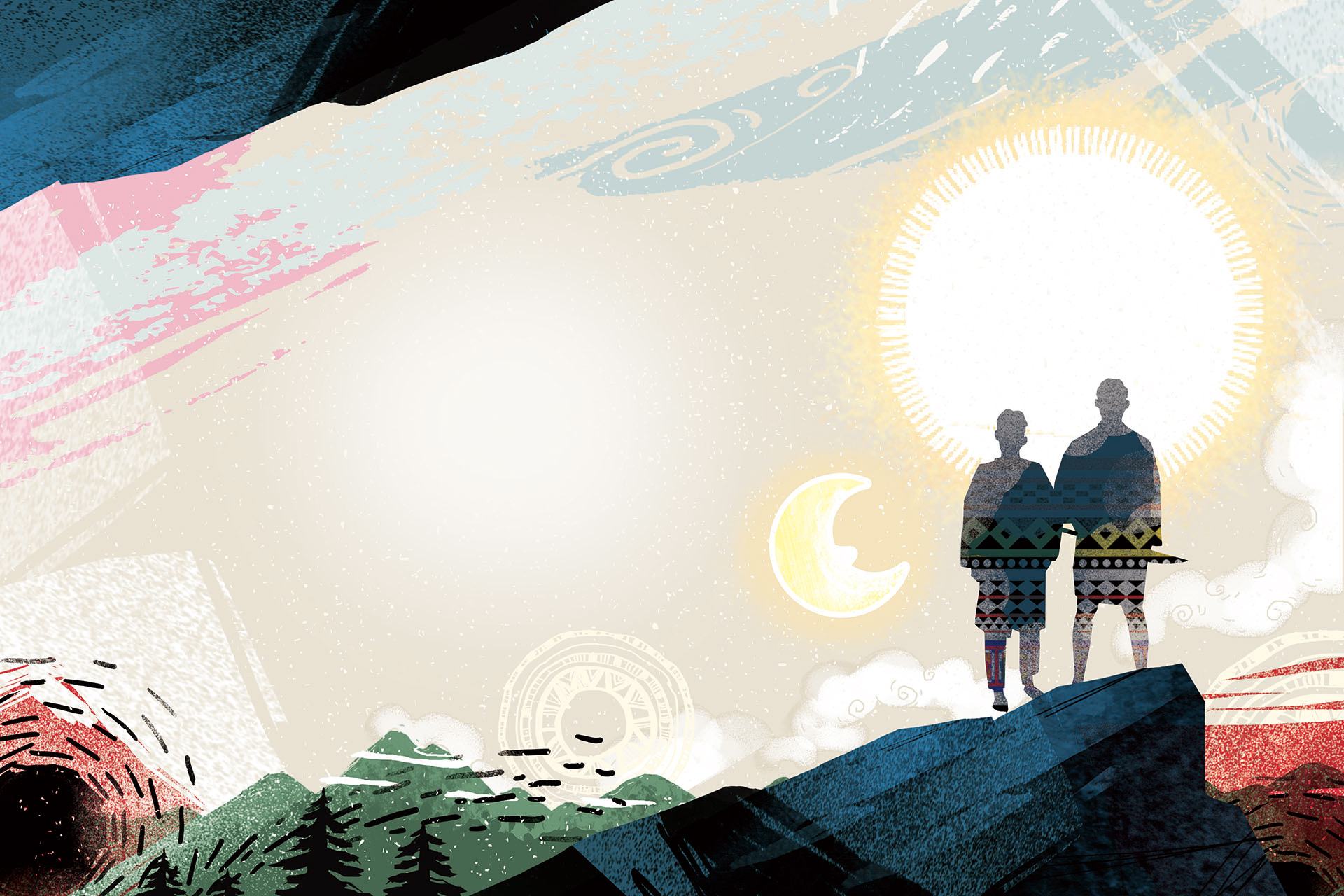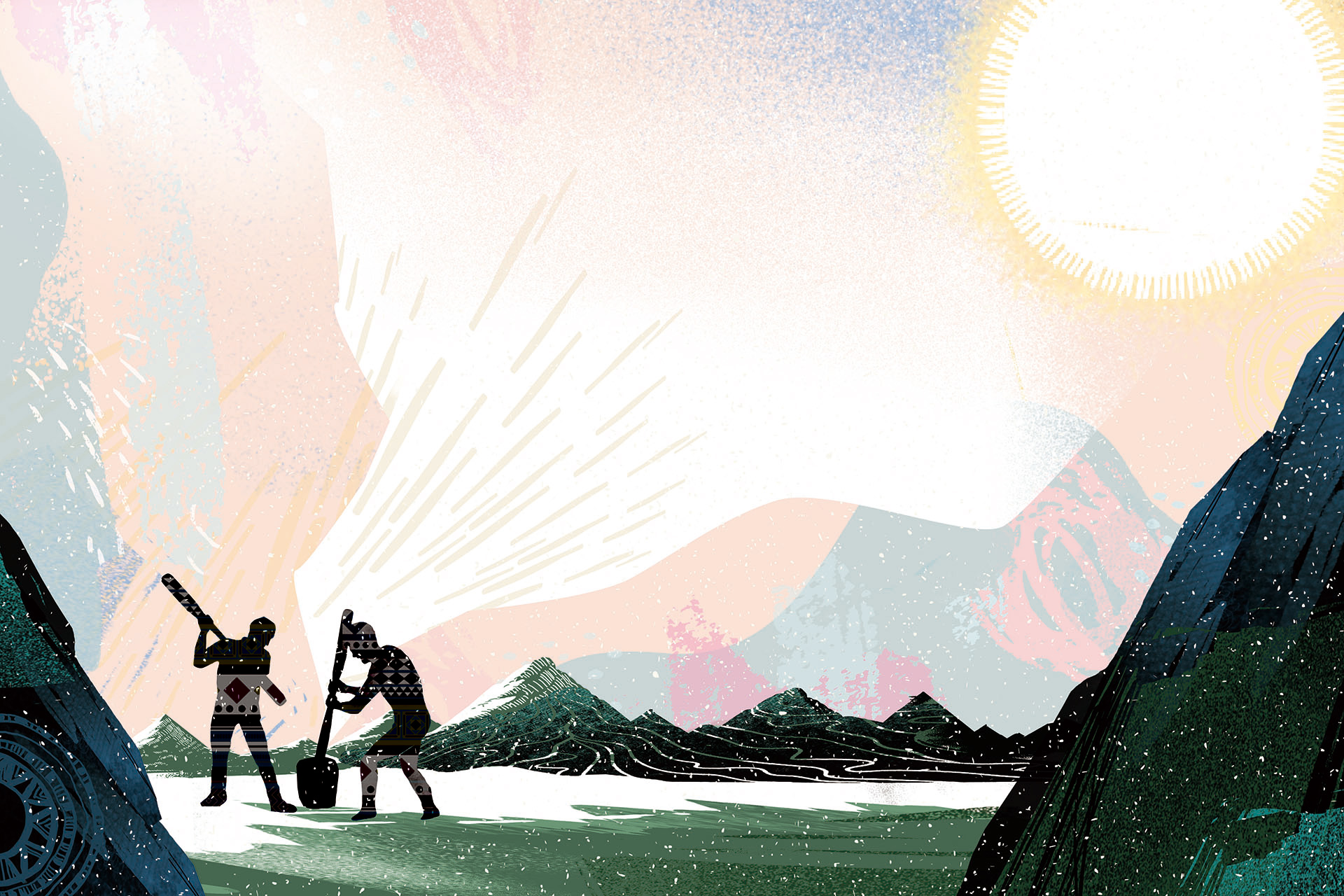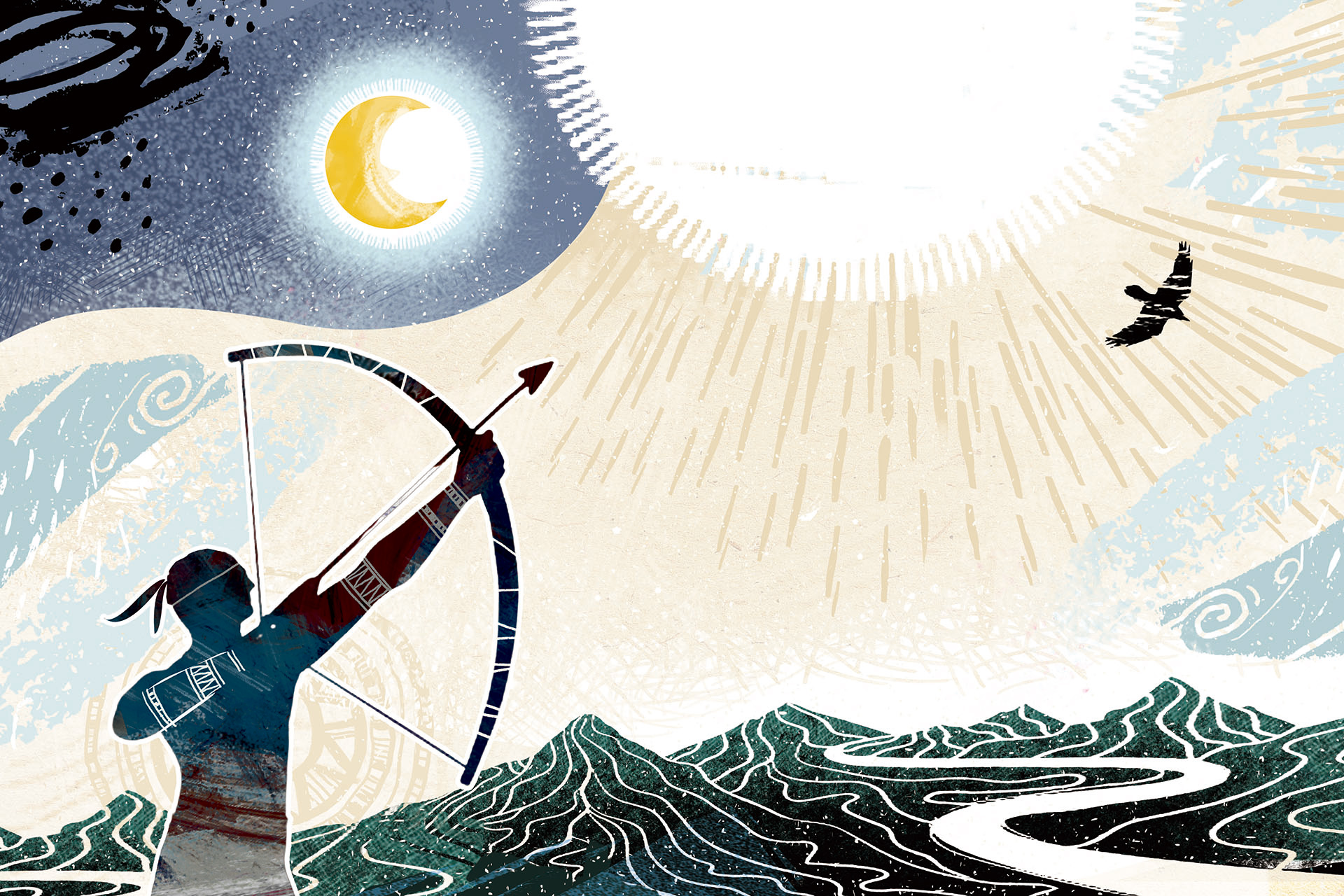One might immediately associate sun shooting legends with Hou Yi.
But did you know
that on this plentiful island there are various sun shooting legends, and that some of them are even more exciting than Hou Yi's?
There are various legends within Taiwan's indigenous stories of sun shooting which can be classified into several types. One type of legends goes that once there were two suns in the sky, and people were suffering as a result. As a solution, brave men from different communities were sent to shoot down one of the suns. The Atayal, Tsou, Bunun, Saysiyat, and Rukai peoples have this type of legend. Although there were two suns in this legend, the long ‘sun expeditions’ that the communities’ warriors undertook had different causes.
The Father and Son's
Sun Expedition
In an ancient Atayal legend, there were two suns in the sky and there was no moon. Thus, there was no cycle of day and night. The earth was extremely hot and living things had difficulty surviving. After much discussion, the community members people agreed that one of the suns should be shot down or the suns would cause a global drought. Three brave men were dispatched to the east for the mission, armed with bows, arrows, and knives. The expedition required a long trip to “a faraway kingdom, ” which seemed like an endless journey. These three brave men felt themselves growing older with white hair, and decided to send one back to report to the community, whilst the other two continued their journey. After listening to the report, the community decided to send another three brave men equipped with dried foods and weapon, and they also each carried one baby boy.
With the fate of the whole community in their hands, these three brave men and three baby boys went straight to the east where they threw seeds of the oranges they ate along their way as markers for the return journey. Time went by as they travelled, and the second dispatched group met the first one and found that they had become white haired old men. The team continued their journey. The elderly in the first and second groups passed away one after one, and the three grown-ups continued according to the will of their fathers to continue the journey. Finally, they arrived at the residence of the suns.
They all pulled the bows to shoot at the unwanted sun and, not surprisingly, it was not affected at all. They then tried a secret weapon that was taught to them by the community elders, and placed a “wuzidasi” (penis) of a wood rat on to the arrow head to shoot the sun. According to the legend, the sun was successfully shut down and oozed with hot blood from the sky, and as it did so the head of one of the young men also poured with blood and he lost his life. The sun that was shut down then turned into a white moon and the blood drops became stars. Since then, there have been days and nights and people no longer suffer with only hot days.

The Drift Wood Son Death God
and the Baby Sun Expedition
Unlike the legend of the Atayal fathers and sons who had worked together with great effort, the Tsou people has a different but equally mysterious sun shooting legend. Once upon a time, there was an orphan girl who had no one to help her hunt, and she had no choice but to go fishing with a net by the river. She did not catch any fish but instead caught a stick of drift wood. She put the stick in her pants pocket and comforted herself with the fact that at least she had caught something. After returning home, she found that her drift wood had disappeared and she had become pregnant.
The baby was named Nebalamuji and this so-called ‘drift wood son’ was smart and had curious abilities: When he raised his hand to point to a bird, the bird died; when he pointed to a deer, the deer died. Even when he used a bow and arrow to shoot at the footprints of animals, these animals mysteriously died. People in the community were not scared of his ability however, but instead laughed at his toy like weapon. Because of this, the “ God Of Death” Nebalamuji was furious and decided to shoot the sun down.
During this time, in the sky there were also two suns and Nebalamuji took his friend with him for the shooting expedition. When they finally reached their destination, they first hid at the place where the suns rest. When one of the suns appeared, Nebalamuji told his friend “when I fire the arrow , you have to jump into the water with me.” Eventually, the sun was shot and oozed with hot fresh blood. Nebalamuji quickly jumped into the water but, due to hesitation, his friend was splashed with the blood of the sun and was killed. When the other sun discovered that his brother had been mysteriously shot, he was scared into hiding. The earth turned dark. The community members were scared and offered sacrifices to the sun. After some time, the sun finally appeared but returned to the west after a while, thus, creating days and nights.
The Angry Father Shoots down the Sun for his Son:
The Promise between the Moon and Bunun
The sun shooting legend of the Bunun people is about the revenge of an angry father for his son. A long, long time ago, there was a diligent couple who went to the field to work every day at the time when the two suns brought the most severe heat.
One day, they brought their little son to the field while they worked, but because the baby could not put up with the hot sun he cried out loud. The mother used a flax seed leaf (sikul) to clothe the baby, but the leaf was dried out by the two suns and not comfortable. The couple had to take turns to carry the baby with a strap, but shortly, the baby stopped crying. After they finished their work, the couple went to attend to their baby and found to their disbelief that it had become a lizard!
The sad father brought his eldest son to help him shoot down the suns and finally, he shot into the eye of the sun. The sun was hurt and wanted to kill the father but it changed its mind after hearing that he had lost his son. It decided to let the father and son leave and to promise that there will be only one sun. The sun that had been shot in the eye gave some seeds to the father and son and told them that it will soon turn into a moon, and that if they follow the change of the moon's shape when planting the seeds, a harvest will come. Because of this arrangement with the moon, the Bunun people conducts their millet cultivation, seedling plantation, weeding, harvest and warehousing at different times in the lunar calendar.

Sun Shooting?
We Do not Need Weapons to Scare the Sun!
Compared to the aforementioned legends in which the main characters tried very hard to shoot down the sun, the Paiwan sun shooting legend is more casual and accidental. The story goes that once, there were two suns that sat low in the sky. Thus, the world had no nights and was very hot. Because there was no night time, all community members had to work without any rest. One day, when pounding millet, Tokanivon accidentally let a wooden pestle bash into the sky, knocking one of the suns down. In doing so, the sky was also elevated and there began the night time. Finally, people could sleep!
In addition to the Paiwan people, the Tao people also has its own similar sun shooting legend. There once were two suns in the sky and because of their super strong energy,, people did not need fire to cook. They only needed to put food under the suns and everything was then done. One day a couple from the Jimowrod village (red-headed village) brought their child to the mountain. They built a canopy to shield their kid from the sun, and went to work in the filed with a peaceful mind. whilst they cooked their food with sun’s rays. However, although their food was well cooked, their kid was killed due to the sun’s strong rays. They were devastated. They hated the sun and pointed their fingers to one of the suns. They cursed, “You go to hell! You burned my son now you must disappear!” The cursed sun was scared off and lost its heat and glare before passing away. Since then there has been only one sun in the sky.
Another Side of Sun Shooting Legends:
The Relationship between the Sun and the Moon
In the aforementioned legends, the moon the sun was turned into the moon after it lost its energy and passed away. But in the legends of the Puyuma and Amis peoples, the sun and the moon are either siblings or husband and wife.
During a great flood, everything was covered with water including the sun and the moon in the sky. In the end, there were just five siblings riding in a hibiscus flower on the sea. Because it was dark, the siblings decided to put one man and one woman into the sky to become objects that could provide light. The man became the sun and the woman became the moon and they took turns to shine on the earth at day and night time.
In the Amis legend, the sun is female which reflects their matriarchal society. In ancient times, the sun and the moon were husband and wife. The sun, as the wife, is independent and outgoing, so the moon decided to leave the sun in order to pursue a better relationship. After the leaving of the moon, the sun began to look for her own happiness. One day, she saw the slender bamboo named “Pro” and found him very attractive. The sun came down from the sky to pursue Pro and wished to marry him. But Pro did not like the personalities of the sun and rejected her, and the sun went back to the sky with regret.
After leaving the sun, the moon felt very lonely and came down to the earth to marry a bamboo with fewer leaves named “Didadu”, but this wife was still very outgoing and passionate. The moon then decided to leave her too and went back to the sky. Later Didadu found that she still loved the moon and tried very hard to climb up in order to make up with the moon. The sky, however, was too high and Didadu could not climb high enough. Since then, the sun and the moon have never got together and the bamboo sometimes grows high into the sky, whilst at other times, it stays low, whispering.

When Others Shut the Sun down,
We Save it
In addition to the common “sun shooting” legends, there are other mythologies handing down by the Thao people. They did not shoot the sun down, but instead saved it, along with the moon.
Once upon a time, there was a young couple. The man was called Brother Dajian and the woman was called Sister Shuidu. They made a living by fishing. One day, the sky and earth were shaking and the sun and the moon disappeared. The world became dark and plants could not grow. People were suffering and thus, this young couple decided to search for the sun and the moon. After a long journey, they found a cave. At the entrance to the cave, an old woman told them that the sun and the moon were eaten by two evil dragons and that she alone was forced to cook for them day and night. The two evil dragons were scared of nothing but the gold axe and scissors which were at the foot of Ali Mountain.
Thus, the couple went to Ali Mountain with a spatula and fire fork which were given to them by the old woman to dig out the gold axe and scissors. Once they had dug them out, they killed the evil dragons and sent the sun and the moon back to the sky. They ate the eyes of the evil dragons which later turned into two high mountains, from which grew a palm tree for the sun and the moon to hold the sky. These two mountains that safeguard the sun and the moon which are located on the two sides of Sun Moon Lake, , and are now known as Dajian and Shuidu Mountain. Each fall, the Thao people holds a ball and dances like the couple holding the sun and the moon.
Like All Living Organisms,
the Sun also Has Life
The indigenous legends of sun shooting demonstrate the impact of the power of nature on life, and reflect the cosmic concept of indigenous peoples that everything has life. So, just like people, when the sun was shot , it bled. The sun as the source of energy will therefore burn people to death with its blood. In the Hou Yi legend that we are more familiar with, the moon and stars were not mentioned. The indigenous legends are filled with imagination and are logically presented. At the same time, the difficulty of the sun expedition was enhanced to teach later generations about the hardworking and persistent spirit of their ancestors. .
The legends of sun shooting told by different peoples are all based on the idea of two suns, and the plots also help us to further understand the worship rituals and lifestyles of indigenous peoples.
- Reference -
林道生編著,《原住民神話‧故事全集》(1~5),臺北市,漢藝色研,2001。
達西烏拉彎‧畢馬(田哲益),《泰雅族神話與傳說》,臺中市,晨星出版,2003。
達西烏拉彎‧畢馬(田哲益),《鄒族神話與傳說》,臺中市,晨星出版,2003。
達西烏拉彎‧畢馬(田哲益),《布農族神話與傳說》,臺中市,晨星出版,2003。
達西烏拉彎‧畢馬(田哲益),《排灣族神話與傳說》,臺中市,晨星出版,2003。
達西烏拉彎‧畢馬(田哲益),《達悟族神話與傳說》,臺中市,晨星出版,2003。
達西烏拉彎‧畢馬(田哲益),《卑南族神話與傳說》,臺中市,晨星出版,2003。
達西烏拉彎‧畢馬(田哲益),《阿美族神話與傳說》,臺中市,晨星出版,2003。
達西烏拉彎‧畢馬(田哲益),《邵族神話與傳說》,臺中市,晨星出版,2003。




